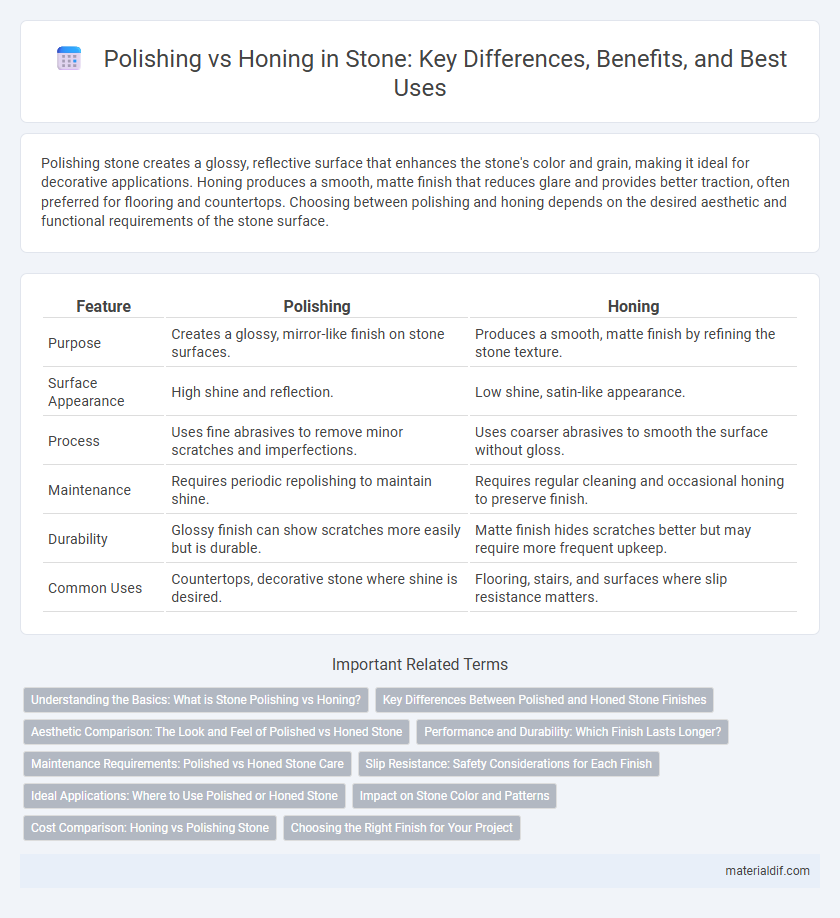Polishing stone creates a glossy, reflective surface that enhances the stone's color and grain, making it ideal for decorative applications. Honing produces a smooth, matte finish that reduces glare and provides better traction, often preferred for flooring and countertops. Choosing between polishing and honing depends on the desired aesthetic and functional requirements of the stone surface.
Table of Comparison
| Feature | Polishing | Honing |
|---|---|---|
| Purpose | Creates a glossy, mirror-like finish on stone surfaces. | Produces a smooth, matte finish by refining the stone texture. |
| Surface Appearance | High shine and reflection. | Low shine, satin-like appearance. |
| Process | Uses fine abrasives to remove minor scratches and imperfections. | Uses coarser abrasives to smooth the surface without gloss. |
| Maintenance | Requires periodic repolishing to maintain shine. | Requires regular cleaning and occasional honing to preserve finish. |
| Durability | Glossy finish can show scratches more easily but is durable. | Matte finish hides scratches better but may require more frequent upkeep. |
| Common Uses | Countertops, decorative stone where shine is desired. | Flooring, stairs, and surfaces where slip resistance matters. |
Understanding the Basics: What is Stone Polishing vs Honing?
Stone polishing involves smoothing the surface to achieve a glossy, reflective finish by using progressively finer abrasives, enhancing the natural color and pattern of the stone. Honing creates a matte or satin finish by removing minor imperfections with abrasives, resulting in a smooth, non-reflective surface that maintains the stone's durability. Both techniques are essential in stone maintenance, with polishing emphasizing shine and honing prioritizing texture and subtlety.
Key Differences Between Polished and Honed Stone Finishes
Polished stone finishes create a glossy, reflective surface that enhances color depth and is highly resistant to staining but can be slippery when wet. Honed finishes offer a matte or satin look with a smooth texture that reduces glare and provides better slip resistance, although they may be more susceptible to scratches and staining. The choice between polished and honed depends on aesthetic preference, functional needs, and maintenance considerations for the specific stone type.
Aesthetic Comparison: The Look and Feel of Polished vs Honed Stone
Polished stone surfaces exhibit a glossy, reflective finish that enhances color depth and creates a sleek, luxurious appearance ideal for modern aesthetics. Honed stone offers a matte or satin texture with a smooth, non-reflective finish, providing a more natural, understated elegance that conceals scratches and wear more effectively. The choice between polished and honed stone significantly influences the overall visual impact and tactile experience of countertops, flooring, or wall cladding.
Performance and Durability: Which Finish Lasts Longer?
Polishing stone surfaces creates a glossy, reflective finish that enhances appearance but may be more prone to scratches and wear over time. Honing produces a smooth, matte surface that resists etching and scratches better, resulting in increased durability for high-traffic areas. In terms of longevity, honing typically offers superior performance by maintaining the stone's structural integrity longer than a polished finish.
Maintenance Requirements: Polished vs Honed Stone Care
Polished stone surfaces require regular cleaning with pH-neutral products to maintain their glossy finish and prevent surface dullness from dirt and oils. Honed stone demands more frequent sealing to protect its matte texture from staining and etching due to its porous nature. Proper maintenance of polished stone typically involves less sealing but careful avoidance of abrasive cleaners, whereas honed stone benefits from routine sealing and gentle cleaning to preserve its smooth, non-reflective appearance.
Slip Resistance: Safety Considerations for Each Finish
Polishing stone produces a glossy, smooth surface that generally offers lower slip resistance, which can increase the risk of slips and falls in wet or high-traffic areas. Honing creates a matte finish with a slightly textured surface that improves grip and enhances safety, making it ideal for flooring in commercial and residential settings. Choosing honing over polishing significantly reduces slip hazards while maintaining the stone's natural beauty.
Ideal Applications: Where to Use Polished or Honed Stone
Polished stone, characterized by its glossy, reflective surface, is ideal for high-traffic areas like countertops, floors, and walls where aesthetic appeal and stain resistance are priorities. Honed stone, with its matte finish and slip-resistant texture, suits spaces such as bathrooms, kitchens, and outdoor patios that require a more subtle look and enhanced safety. Selecting the appropriate finish depends on balancing visual preference with practical considerations like maintenance and durability.
Impact on Stone Color and Patterns
Polishing stone enhances its color and patterns by creating a glossy, reflective surface that intensifies the natural hues and intricate details of the material. Honing produces a matte or satin finish, softening the stone's appearance and muting color vibrancy while preserving texture and pattern clarity. The choice between polishing and honing significantly affects the stone's aesthetic appeal and how light interacts with its surface.
Cost Comparison: Honing vs Polishing Stone
Honing stone generally costs less than polishing stone due to its finer but less intense abrasive process, making it a budget-friendly option for surface refinement. Polishing stone, while more expensive, delivers a higher-gloss finish and greater smoothness, often justifying the added cost for premium aesthetics. Choosing between honing and polishing stone depends on budget constraints and the desired final appearance of the stone surface.
Choosing the Right Finish for Your Project
Selecting the right finish for your stone project depends on the desired appearance and durability; polishing enhances shine and highlights natural colors, while honing provides a matte, smooth surface that's less reflective and more slip-resistant. Polished stone surfaces are ideal for areas requiring a luxurious, glossy look, such as countertops and decorative features, whereas honed finishes suit high-traffic flooring or outdoor applications needing subtle elegance and practicality. Understanding the specific requirements of your project ensures the appropriate finish balances aesthetics with functionality for long-lasting results.
Polishing vs Honing Infographic

 materialdif.com
materialdif.com